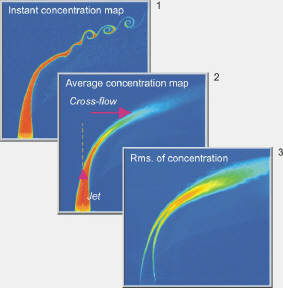Planar Light-Induced Fluorescence (PLIF) is a method of measuring flow concentrations on a large area. Its ability to measure concentrations makes it suitable to infer thermal properties of a fluid, and in correlation with velocity data is can be used to determining flow fluxes, turbulent diffusion coefficients, and other properties. Like many other techniques, it is non-invasive with the exception of seeded dye and/or particles. PLIF mostly employs the use of laser light bent into a sheet via a lens. Dye typically used fall within the category of Fluorescein, which is a dye that absorbs light of a given spectrum (such as laser light) and re-radiates light in a range that our eyes and cameras can see. The "2D" nature of the imaging plane simplifies computer correlation, and is suitable for a wide range of applications.

 PLIF requires calibration in order for it to produce useful information. Calibration is made necessary due to changing concentrations of dye. Concentration changes vary the relationship (from linear to exponential) between the computed signal and measured factors of the system - namely dye concentration, temperature, light intensity. Interpretation of the information can be handled in several ways, including a 'snapshot' of the flow that reveals momentary concentration information, and a concentration map that is the average of many 'snapshots,' and can be used to infer the amount of mixing that is occurring. Correlation of velocity information is usually performs with PIV systems, which track the seeded particles in the flow.
PLIF requires calibration in order for it to produce useful information. Calibration is made necessary due to changing concentrations of dye. Concentration changes vary the relationship (from linear to exponential) between the computed signal and measured factors of the system - namely dye concentration, temperature, light intensity. Interpretation of the information can be handled in several ways, including a 'snapshot' of the flow that reveals momentary concentration information, and a concentration map that is the average of many 'snapshots,' and can be used to infer the amount of mixing that is occurring. Correlation of velocity information is usually performs with PIV systems, which track the seeded particles in the flow.
Images from this page can been seen in an informational brochure from Dantec Dynamics